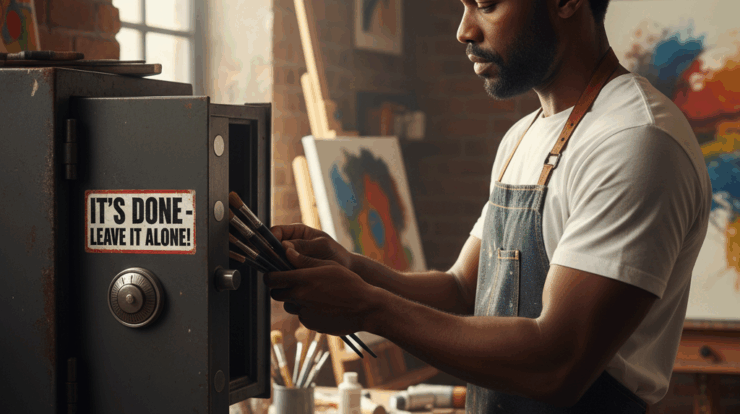
Every artist has done it—you send an image of a piece to a gallery, a publication, or post it online, and then, an hour later, notice something that bugs you. A line you’d like to soften. A shadow that feels off. You think, It’ll just take a minute to fix.
But here’s the truth I’ve learned from years of working with artists and promoting their work: once an image is out in the world, the piece needs to be considered done.
Once It’s Out There, Freeze It
As soon as a photo of your artwork has been shared—whether with your gallery, a collector, or online—it becomes part of a record. That image may already be in email threads, on websites, or even queued for a publication.
Changing the artwork after that moment might seem harmless, but it creates ripples that are hard to contain. Suddenly, there are two versions of the same piece circulating—one the gallery has, one you’ve updated. Collectors, editors, or printers might not even realize they’re different until the discrepancy causes confusion.
Why Post-Submission Edits Cause Headaches
For galleries, consistency is everything. Titles, dimensions, and images need to match across the website, price lists, catalogs, and printed materials. If you send an updated image after we’ve already shared it with clients or queued it for a show, it’s not just one fix—it’s a cascade of small errors that can take hours to untangle.
Even a subtle change—a shifted color, a slightly different composition—can lead to awkward conversations:
“Wait, this doesn’t look like the piece I saw online.”
It may seem small, but these inconsistencies can chip away at professionalism and trust.
If You Must Make a Change
Sometimes revisions are necessary. Maybe you realize there’s a genuine flaw that affects the work’s integrity, or a coat of varnish shifts the color balance. If that happens:
-
Alert the gallery immediately. Don’t assume they’ll spot the difference. Tell them the piece has changed and that you’re sending an updated image.
-
Send the new photo right away. Label it clearly—use the same title and mark it “updated.”
-
If materials are already in production, call instead of emailing. Once something’s headed to print, a quick phone call can prevent a small issue from becoming an expensive one.
The key is to treat your gallery—or any partner you work with—as part of your team. Communication keeps everyone aligned and your presentation professional.
Done Means Done
Finishing a painting is never neat. There’s always one more tweak you could make. But at some point, you have to let the work go. The moment you hit “send,” that piece becomes part of your public body of work.
So take your time before that final photograph. Step back, live with the piece for a day or two, and only share it once you’re confident it’s finished. After that, resist the urge to revisit.
Art isn’t perfect—it’s alive. And sometimes the most professional thing you can do is stop painting, press send, and move on to the next one.
Have You Ever?
Have you ever changed an artwork after sharing images publicly? Did you run into trouble because of it? Share your experiences and thoughts in the comments below.